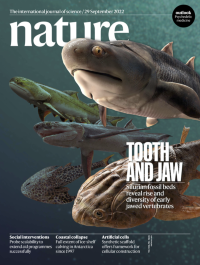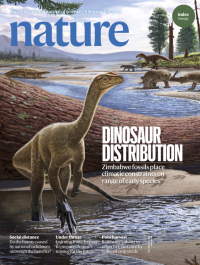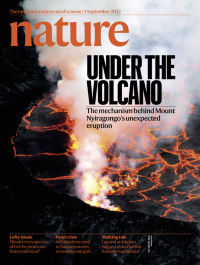Volume 609
-
No. 7929 29 September 2022
Tooth and jawThe cover shows an artist’s reconstruction of (from top to bottom) Shenacanthus vermiformis, Fanjingshania renovata, Qianodus duplicis, Tujiaaspis vividus and Xiushanosteus mirabilis, five newly discovered species of ancient fish from the Silurian Period. Fossil remains of these fish are among those found in two well-preserved beds in southern China dating to 436 million to 439 million years ago. The fossil beds were uncovered by Min Zhu and his colleagues, who discuss the remains they contained across four papers in this week’s issue. The exceptional preservation of the fossils has allowed the researchers to shed light on the difficult problem of how jawed animals evolved and diversified. Among the finds are the oldest known teeth from any jawed vertebrate — from Qianodus, a previously unknown shark relative. Together, the findings paint a fresh picture of diversity among jawed animals of the early Silurian.
-
No. 7928 22 September 2022
Builder dronesGround-based robots have potential for helping in the construction industry, but they are limited by their height. In this week’s issue, Mirko Kovac, Robert Stuart-Smith and their colleagues introduce highly manoeuvrable aerial robots that can perform additive 3D construction tasks. Inspired by natural builders such as wasps and bees, the researchers created BuilDrones (as shown on the cover) that can work in an autonomous team to perform 3D printing tasks using foam- or cement-based materials. They also created ScanDrones to assess the quality of the structures being built. The team hopes that this approach of ‘aerial additive manufacturing’ could help to build structures in difficult to access areas.
-
No. 7927 15 September 2022
Melting plotThe cover shows melting sea ice in the Arctic during August 2018 photographed from the Alfred Wegener Institute’s airborne sea-ice survey IceBird. Climate change is diminishing Arctic sea ice at rate unseen for some 1,000 years. But mapping sea-ice thickness during the crucial melt period from May to September has not readily been possible. In this week’s issue, Jack Landy and his colleagues provide estimates of Arctic sea-ice thickness for the whole year. The researchers used deep learning and numerical simulations of observations collected by the ESA CryoSat-2 satellite to generate their data set for the melt period, verifying them with IceBird’s airborne measurements. The team hopes the year-round record for sea-ice thickness will enable better understanding of climate feedbacks in the Arctic.
Nature Outlook
-
No. 7926 8 September 2022
Dinosaur distributionThe cover shows an artist’s impression of Mbiresaurus raathi, a newly discovered species of herbivorous dinosaur found in Zimbabwe and dating to around 230 million years ago. The remains of the sauropodomorph were part of a collection of fossils from the Late Triassic that contains Africa’s oldest known dinosaurs. Discovered by Christopher Griffin and colleagues along with palaeontologists at the Natural History Museum of Zimbabwe, these fossils are discussed in this week’s issue. The researchers note that the remains correlate with those of similar vertebrates found in the same latitude band in South America and India, suggesting that the distribution of the dinosaurs correlated with climatic barriers. The team notes that this agrees with the idea of arid and humid climate belts running east–west across the supercontinent Pangaea, indicating that the range of these early dinosaurs was constrained to southern Pangaea until those climatic barriers relaxed.
Nature Index
-
No. 7925 1 September 2022
Under the volcanoThe cover shows the open lava lake of Mount Nyiragongo in the Democratic Republic of the Congo before its catastrophic drainage. The run-up to a volcanic eruption is usually characterized by geophysical and geochemical signals, which can form the basis of an early-warning system. However, as Delphine Smittarello and her colleagues discuss in this week’s issue, that was not the case for last year’s eruption of Nyiragongo. Fissures opened up in the flank of the volcano on 22 May 2021 at the start of a six-hour eruption that began with virtually no warning. Confounding standard theories of how eruptions start, Nyiragongo went on to experience seismic activity for days after, rather than before, the eruption. Modelling by the researchers suggests that the eruption was driven by a rupture in the volcano’s edifice, which subsequently caused a magma intrusion through a 25-km long dyke some 500 metres below the ground. The dyke progression was responsible for the main felt seismic activity. The team notes that forecasting such events is exceptionally hard, suggesting that greater emphasis should be placed on subtle precursory signals and advance preparation for such hazards.





